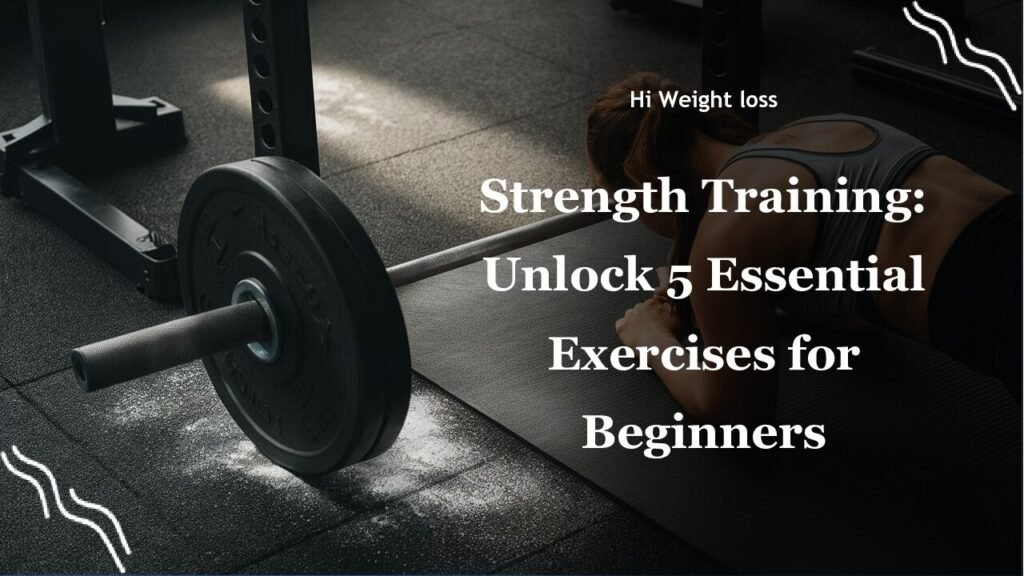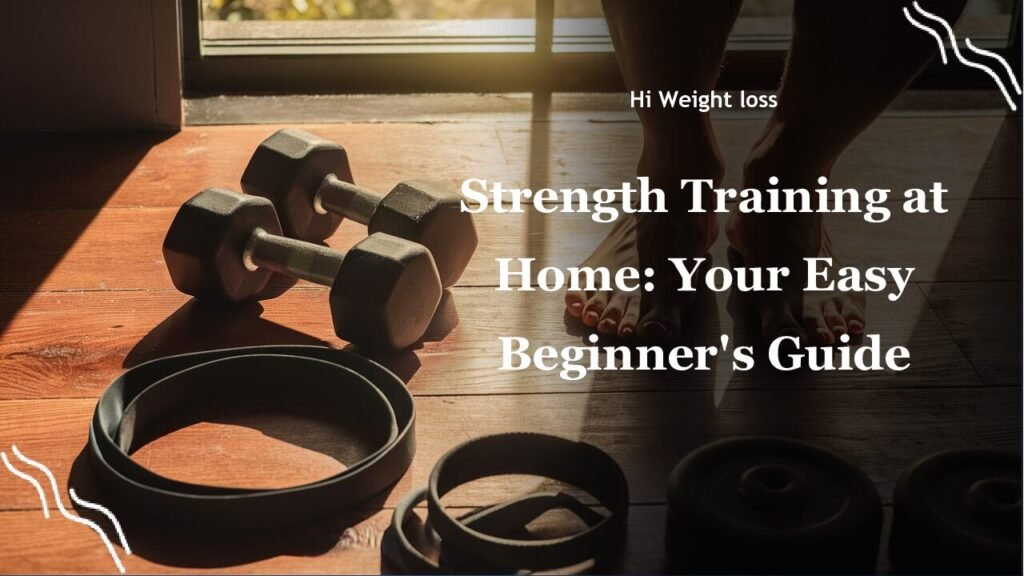Are you feeling lost in the gym, unsure where to begin with strength training? It’s a common frustration, feeling like everyone else knows the secret moves, while you’re just trying to avoid injury. The truth is, there are five basic strength training exercises that form the foundation of any effective workout program. In this blog post, we’ll dive into these essential exercises, explain why they’re so important, and give you practical tips to get started, drawing on my own experiences and research to guide you.
The 5 Basic Strength Training Exercises Every Beginner Should Know
Why These Five Exercises?
Before diving into the specifics, let’s talk about why these five movements are so crucial. They’re not just random exercises; they are compound movements. This means that they work multiple muscle groups simultaneously, leading to more efficient workouts and better overall strength gains. Think of it like building a house: you wouldn’t just focus on one brick, you’d want a solid foundation that involves many different elements. These exercises provide that foundation.
1. The Squat: Building Lower Body Power
The squat is often called the king of all exercises, and for good reason! It targets the quads, hamstrings, and glutes, creating strong and powerful legs. I remember when I first started, squats felt awkward. My knees wobbled, and I struggled to maintain proper form. It was frustrating, but with practice and guidance, I began to see real improvements not just in leg strength but also in my overall balance and athletic ability. Squats also are important for improving functional fitness, which is how well you move in your everyday life.
When you’re performing a squat, it’s important to focus on form. Stand with your feet shoulder-width apart, lower yourself as if you’re sitting in a chair, and keep your back straight. The depth of your squat can vary based on your mobility. If you can only go to parallel, that’s fine. The goal is consistency and controlled movement, not ego lifting.
2. Deadlifts: A Full-Body Strength Builder
Next up, the deadlift, often viewed with a mix of fear and respect. The deadlift is a compound exercise that targets many muscle groups, including the back, glutes, and hamstrings. When I first tried deadlifts, I was intimidated by the weight. It seemed like a recipe for a back injury. But with proper instruction, I learned that it’s one of the best exercises to build overall strength and improve posture, especially if you spend a lot of time sitting.
A good deadlift involves bending at the hips, keeping your back straight, and lifting with your legs. It’s crucial to learn proper form. If you’re unsure, consult a fitness professional, especially when starting out. Deadlifts will make your whole body stronger, and help you become more resilient. Remember, it’s okay to start light and work your way up gradually, what matters most is your form, not the weight on the bar.
3. The Overhead Press: Upper Body Strength
Moving to the upper body, we have the overhead press, also known as the shoulder press. This exercise is excellent for building pushing strength and targets the shoulders, triceps, and upper chest. It’s a key element in higher skill movements such as the clean and press. It’s a move that really makes you feel strong and empowered. When I first tried an overhead press, I was surprised how much it required not only shoulder strength, but also core stability. I quickly realized it wasn’t just about the arms, it was about the entire upper body and midsection working in unison to push weight over my head.
When you do the overhead press, keep your core engaged and use a controlled motion. Start with a lighter weight and focus on proper form. Standing in a stable position is critical, as is keeping your back straight and your movements smooth. You will quickly find this is an exercise that makes you feel like you’re making real progress with building strength.

4. Pull-Ups: Master of Upper Body Pulling
The next essential is the pull-up. Many people consider this exercise to be the pinnacle of upper body pulling strength. It primarily develops the back and biceps. Pull-ups are an exercise that I struggled with for a long time. I could barely do one when I started out. With consistent practice and assisted exercises, I was eventually able to do a few. It was such a rewarding feeling, and it significantly improved my back and bicep strength. It’s important to start where you are, and with support and time, you will see how strong you can be.
If you cannot do a full pull-up, don’t worry. You can use assistance methods such as resistance bands or an assisted pull-up machine. Your aim is to work up to full pull-ups with a full range of motion, and with time and consistency, you will get there. Keep focused and you will be able to see your progress.
5. Planks: Your Core Strength Powerhouse
Finally, we have the plank, a simple yet incredibly effective core exercise. Planks are great for strengthening your midline, engaging your shoulders and back, improving the weights you lift in your workout routines, and boosting overall stability. My experience with planks was initially one of frustration. Holding that position for even a short amount of time felt like agony, but with consistent effort, I realized it was the most effective way to feel my entire core engage, and it improved my ability to do other exercises.
To perform a plank, get into a push-up position, but rest on your forearms instead of your hands. Keep your body in a straight line from head to heels, engage your core, and breathe. Start with a shorter duration, and build up your time as you become stronger. The plank is a great way to strengthen your core and improve your lifts.
Integrating These Exercises Into Your Routine
Now that you know about these five basic exercises, how should you integrate them into your routine? It’s best to start with 2-3 times per week, and ensure you have rest days in between workouts. You can start with a few sets of each exercise, and as you build up your strength, gradually increase the amount of weight you are using. Consistency is really the most important part of building strength. You will need to gradually increase the weight, sets and reps, but make sure you focus on proper form and consistency first.
Remember, progress is not linear. Some days, you might feel stronger, while others you might feel a little weaker. This is normal, and what is important is that you listen to your body, ensure you get enough rest and nourishment, and keep on going. With the right approach, the right exercises, and the right mindset, you can build a strong and resilient body.
Here’s a table summarizing the key aspects of each exercise:
| Exercise | Primary Muscles Targeted | Key Benefits | Personal Tips |
|---|---|---|---|
| Squats | Quads, hamstrings, glutes | Improves lower body strength, functional fitness | Focus on form, not depth; knees can track over toes |
| Deadlifts | Back, glutes, hamstrings | Builds overall strength, improves posture | Start light, focus on hip hinge |
| Overhead Press | Shoulders, triceps, upper chest | Builds upper body pushing strength | Engage core, controlled motion |
| Pull-Ups | Back, biceps | Develops upper body pulling strength | Use assistance if needed, build up gradually |
| Planks | Core, shoulders, back | Strengthens core, improves stability | Keep straight line from head to heels, engage core |
Conclusion
Embarking on your strength training journey can feel daunting at first, but by focusing on these five fundamental exercises, you can lay the foundation for overall strength, fitness, and resilience. The squat, deadlift, overhead press, pull-up, and plank are more than just exercises; they’re tools that can transform your body and empower your life. Drawing from personal experience, each of these exercises has been instrumental in my own fitness journey, building both physical and mental fortitude. Remember, consistency, proper form, and gradual progress are the keys to success, and they will help you reach your goals. Don’t wait, get started today!
What exercises will you start with? Consider sharing this article with a friend who is beginning their fitness journey. Or maybe, if you’re already fit, consider supporting someone who’s just getting started!
FAQ
1. How often should I do these exercises?
Aim for 2-3 times a week, with rest days in between. This allows your muscles to recover and grow stronger. Remember that consistency is key, so aim to be as regular as possible with your workouts.
2. Do I need to use weights right away?
No, you can start with bodyweight exercises to master the proper form, then gradually add weight. It is more important to ensure you are using the correct form first before loading up on the weight.
3. What if I can’t do a full pull-up?
Use assisted methods like resistance bands or a pull-up machine. With consistency, you’ll be able to do unassisted pull-ups soon. Just remember, Rome was not built in a day, and fitness is a journey.
4. How long should I hold a plank for?
Start with 20-30 seconds and gradually increase the time as you get stronger, or if you need a challenge you can increase the amount of time you hold the position for. Ensure that you are still focused on engaging your core and keeping your back straight.
5. Should I see a fitness professional?
If you’re unsure about your form, it’s a great idea to consult with a fitness professional. They can provide specific guidance to ensure you stay safe and get the most out of your exercises.



